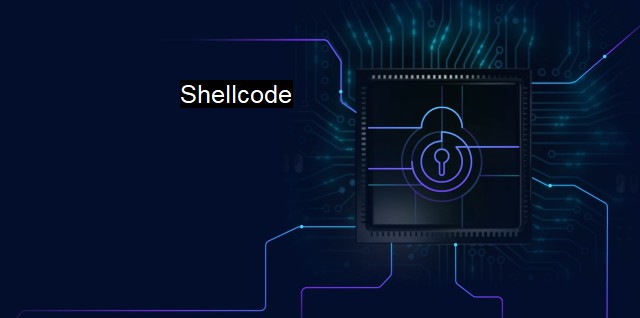What is Shellcode?
The Threat of Shellcode: How Malware Exploits Vulnerabilities to Steal Data and Disrupt Operations in Cybersecurity
Shellcode is a crucial concept in cybersecurity parlance. Pertaining to the realm of computer programming and information security, it refers to a small piece of code used as the payload in the exploitation of a software vulnerability. It's named "shellcode" because it typically starts a command shell—an interface that allows users to manipulate services of an operating system—from which a user or a malicious attacker can control the compromised machine.Written in machine language and crafted to suit specific instances of exploits, shellcode is traditionally used by attackers seeking unauthorized system access. It is usually the final payload delivered by the attacker after exploiting a buffer overflow, format string, or another type of vulnerability within an application. In penetration testing, ethical hackers use shellcodes to exploit weaknesses and demonstrate the impacts of vulnerabilities to strengthen the defense procedures and technologies.
Shellcode is often associated with the architecture of the targeted machine and the specific operating system in use. This results in shellcode needing to be carefully crafted, taking considerable skill. Basic shellcode will merely give access to a command shell; advanced shellcodes allow remote control of the machine, execute a series of commands, or install malicious software like a backdoor to gain access whenever needed.
The intricacies involved in writing shellcode are multi-fold. It must be written in raw machine code, be as small and efficient as possible to avoid detection, and avoid having null bytes or characters that can terminate the string prematurely or cause incorrect execution. It must also successfully interact with the system's kernel through system calls, which in itself is a difficult and precise undertaking.
To complicate things further, various protection mechanisms and antivirus solutions have been developed to detect and deter standard shellcode exploits. Techniques such as Address Space Layout Randomization (ASLR) and Data Execution Prevention (DEP) have been employed to disrupt the attacking shellcode and limit its effectiveness. As a result, creating a working shellcode in today's cyberspace can be challenging.
The nature of mutable shellcodes has prompted responses from the cybersecurity industry, leading to the development of more capable antivirus systems. Antivirus solutions work aggressively to detect and dissolve general classes of shellcode, identifying suspicious activity through heuristics. network-based intrusion detection systems search for patterns related to shellcode in network traffic for quick identification and eradication of threats.
Cybersecurity researchers and penetration testers continue using exploits and shellcodes to evaluate system vulnerabilities and help develop more effective protective tools. Getting ahead of potential attacks requires continuous effort; as attackers grow more sophisticated, so too does the technology developed to stop them.
"Polymorphic" and "Metamorphic" shellcodes present another complex scenario. Polymorphic shellcode alters its signature every time it executes, making it highly evasive to standard detection methods. Conversely, metamorphic shellcodes change their structure without altering the ultimate effect. This advanced morphing enables the shellcode's evasion from signature-based and behavior-based detection schemes, thereby boosting its potency and stealth.
Shellcode encapsulates the internal battle between malicious hackers and defenders within the field of cybersecurity. The continuous improvement and modification of shellcodes, in tandem with the evolution of protective measures, exemplify information security's dynamic nature. Understanding shellcodes and their intricacies is crucial within the cybersecurity sphere to build robust defenses to protect against threats- a step critical in maintaining the stability and integrity of online spaces.

Shellcode FAQs
What is shellcode in cybersecurity?
Shellcode is a piece of code that is injected into a vulnerable software application to perform an attack. It is usually written in machine language and is used to exploit software vulnerabilities.What is the purpose of shellcode?
The main purpose of shellcode is to gain remote access to a compromised system and take control of its resources. It is commonly used by hackers and cybercriminals to install malware, steal sensitive data, or launch other types of attacks.How do antivirus programs detect shellcode?
Antivirus programs use a variety of techniques to detect shellcode, including signature-based detection, behavioral analysis, and heuristics. Signature-based detection involves looking for known patterns of malicious code, while behavioral analysis looks for suspicious behavior. Heuristics involves looking for code that has characteristics commonly used by malware.How can you protect your system from shellcode attacks?
To protect your system from shellcode attacks, it's important to keep your software applications up-to-date with the latest security patches. You should also use antivirus software that can detect and remove malware, as well as firewall software that can block incoming attacks. In addition, it's important to be cautious when opening email attachments or clicking on links from unknown sources.| | A | | | B | | | C | | | D | | | E | | | F | | | G | | | H | | | I | | | J | | | K | | | L | | | M | |
| | N | | | O | | | P | | | Q | | | R | | | S | | | T | | | U | | | V | | | W | | | X | | | Y | | | Z | |
| | 1 | | | 2 | | | 3 | | | 4 | | | 7 | | | 8 | | |||||||